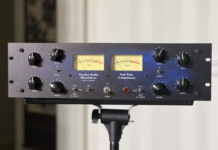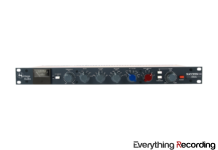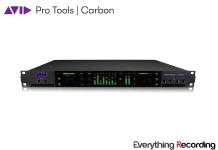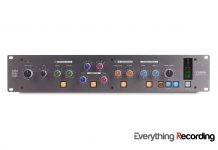Sometimes when we review a product from another country, the tendency is to open with a quick quip about it being from the land of fine meats and cheeses, their abundance of elk or whatever else the Wikipedia search turns up. Beyond the iconic countryside scenes of “The Sound Of Music“, Austria’s most notable exports have come from Akustische und Kino-Geräte Gesellschaft m.b.H, better known to the world as “AKG”. AKG certainly need absolutely no introduction, their contributions to pro audio would be an article unto itself.
However, as tends to happen with corporations, they are often acquired, absorbed, repositioned, retooled, diversified and a dozen other terms spoken by MBA’s everywhere. For AKG, this meant their parent company (Harman International) was acquired by THEIR new parent company Samsung and relocated to California in 2017 – leaving a furloughed design team and factory in Austria. Rather than simply closing up shop, they created Austrian Audio, with a renewed focus and independent spirit.
Austrian Audio’s forebearer has always been a very serious player in the professional and consumer headphone market – leaving our new upstart with a big set of earcups to fill. Rather than just rehashing existing AKG designs and trading upon the legacy with a new logo, Austrian Audio have quickly made it abundantly clear that this is not how they plan on doing things.
ENTER THE HI-X55
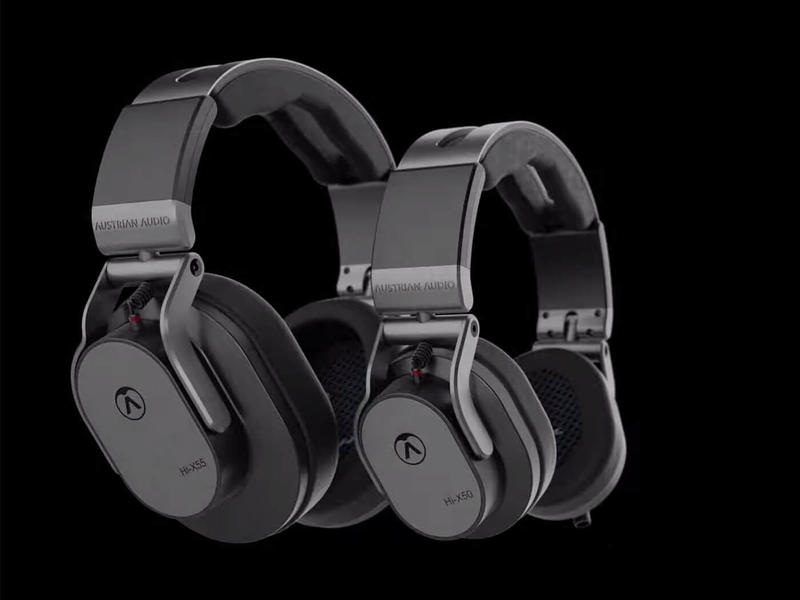
With just an initial look at the Hi-X50 and Hi-X55 headphones, you immediately know that these are not a retread of existing patents, but a new concept with tremendous attention to detail and innovation. The Hi-X55’s we’re reviewing here are the over-ear version of their ‘high excursion’ design (there’s your ‘Hi-X’ designation right there). Sporting 44mm drivers and a stated 5hz-28kHz frequency range, the Hi-X55’s feature 118db of sensitivity and a relatively low 25ohm resistance.
There has been more chatter about headphone impedance in the past year than the previous fifty combined. What you need to know (lest you get sucked into a vision quest of online discussions) is that a lower impedance means the drivers’ voice coils have less resistance to incoming current. That means slightly lesser-powered sources (say for example, your phone or audio interface’s headphone amplifier) are able to provide enough amperage to make these shine. Other designs, notably from Beyer Dynamic, offer models with resistance as high as 600ohms – which really need a big heckin’ chonker of a headphone amp to be driven in their optimal range.
Speaking of voice coils, this is the very heart of the Hi-X55’s technical advancement. Building upon the ring-magnet design of their lineage. Austrian Audio’s design features a copper-wound aluminum driver that is able to move more freely due to the reduced weight. This means not only a faster response time, but (you guessed it) deeper driver excursion. Those sub frequencies today’s electronic music producers crave move the drivers deeper, farther and faster. A 30hz sine wave practically transforms these headphones into a portable massager, should your shoulders be a little tight from agonizing over your mix all day.
Though the Hi-X55’s do not fully fold inside the headband, the earpieces do pivot to lay flat for easy transport. I personally would not take my studio headphones away from home the same way I don’t take out any other gear or instruments. Headphones get dropped, stolen, lost and forgotten. At an MSRP of $299, I’ll stick to walking the dog with my cheap $50 pair instead. These are just as much an instrument as anything else in my studio, and I treat them as such.
THE ‘X’ FACTOR

As much as I try not to be swooned by appearances, the first time I saw the Hi-X55’s press release in my inbox, my idful, gear-lusting side wondered, “Ohhh…. Now what, pray tell, are these?!?” From the head-conforming forward-canted earpieces to the low-profile but handsomely-padded headband, the profile and materials let you know this is a design that’s equal parts evolution and revolution.
At that point I hadn’t even received my evaluation pair. And to be frank, I’m always a skeptic of product photos with so many being 3D-model renders anyways. But cracking open the shipping box, I suddenly understood all of those stupid unboxing videos you see on YouTube (do you seriously expect me to watch you open your new iPhone?). I had to pace myself as the initial presentation of the box made me linger… opening the red sash to its bewitching black matte box was disarmingly… seductive.
Internal dialogue: “No… stop…. Our readers already think I’m unstable… Lay off the Harlequin Romance Novels and get to the good stuff!”
Inside the Hi-X55’s box, you’ll find a velvety black carry pouch, a detachable 3.5mm cable with threaded ¼” TRS adapter and the documentation that I suspect no person has read, like, ever (seriously, if you’re an audio engineer who needs instructions for headphones, reevaluate your career choice). Oh, and a sticker – the most brilliant free advertising method ever conceived.
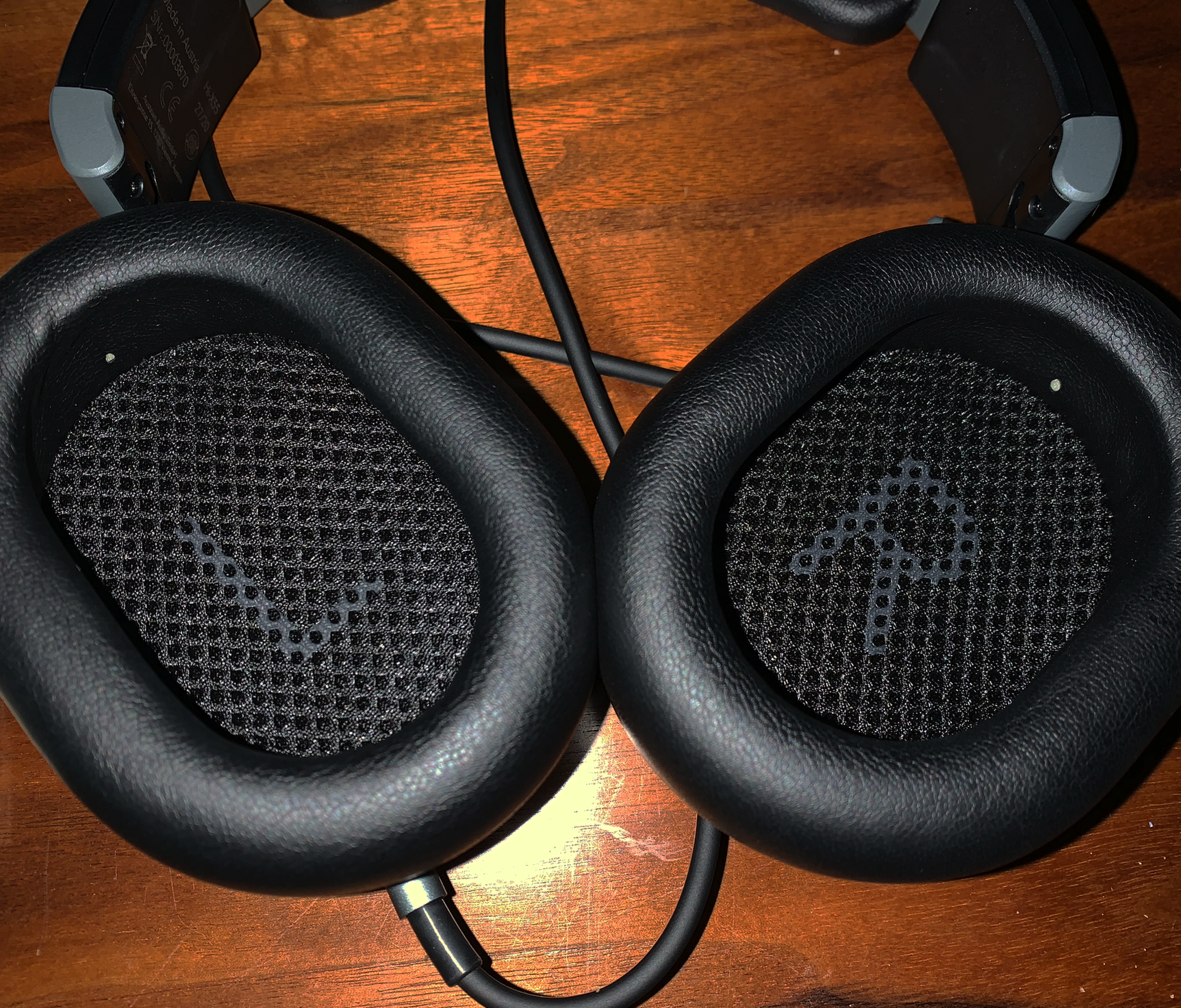
Slipping the pair on and finding the “just right” spot on the extendable steel bows, it felt like sliding into the leather interior of a luxury automobile. Though the Hi-X55’s earcups are smaller than some of its contemporaries, they nestled perfectly over my ears with great economy of space and comfort. The importance of this fit can’t be overstated if you’re planning on wearing them for any extended amount of time. As a side note, screening the “L” and “R” inside the earpieces is a nice touch for those who don’t know the cable is ALWAYS on the left.
Though there is a fair amount of high-tensile plastic involved here, all of the usual places headphones break sported reassuringly sturdy metal joints and contact points. At just a penny over 300g (about 10.5oz to US Imperialists) the Hi-X55’s felt nice and light, almost as little as the Hi-X50’s smaller on-ear design. Those of us who’ve owned the two-pound “DJ’s delight” type headphones with 50mm+ magnets and way too much padding will appreciate giving your poor old neck a break.
Though the Hi-X55 is a closed-back design, they don’t completely seal you away in their own anechoic world the way some designs do. Honestly that has always made me feel a touch claustrophobic, even though pretending that the person trying to talk to me is singing along with the music playing inside is always entertaining. Try it with “Bohemian Rhapsody”, it’s hilarious.
THE FUTURE SOUND OF VIENNA
I will admit, I haven’t always been a heavy user of headphones when mixing. I’d use them to hear the mix folded to mono to check for phasing and make sure my poor old ears hadn’t fatigued for the day, leaving a shearing amount of high-end. But when I relocated my studio to New York City, space, acoustics and acceptable volume suddenly all became an issue. No more tracking live drums at 3AM – to say the very least.
At first, I used my trusty Sony V700’s from my DJ days which are fun to listen to, but an incredibly bad choice for making value judgments on EQ, balance and compression. DJ headphones have a knack for making just about anything sound good. I moved onto an audio-focused pair and found them helpful, but would only use them for working late at night or for the above-mentioned “gut check”. Why? Simple. I didn’t like them and they didn’t match the monitors OR the final mixes.

Plugging into my DIY’d headphone amp (seriously, I’m not paying $350 for 2 hours of work and $70 in parts), I went right back to a mix I’d been laboring over for a day or two (okay, more like ‘repeatedly getting frustrated and walking away from’) to hear Austrian Audio’s perspective. My first reactions? Present. Like, right there present. I was now nose-to-nose with the drums and guitars. The thwack and plump of the kick drum, the pang and ‘puh’ of the snare were so close I could smell the drummer’s breath (don’t forget to floss!). The guitars, particularly the hard-panned rhythm pair, were now firmly planted to the sides of my head like an Alien facehugger. Present and accounted for.
While something like a bass drum will never give you that kick to the chest that you’ll experience on actual speakers, I definitely could work deeper on EQ’ing into that sweet spot. And the Hi-X55’s quickly revealed to me that imaging of the room mics and overheads needed a wee-bit more aligning – which they gladly helped me find. Switching back to my monitors, everything seemed so much more properly spaced out in the stereo field. Okay, Austrian Audio. You have my attention.
JUST LISTEN…
Switching over to one of my favorite ever EDM tracks for system-checking, I absolutely loved how the Hi-X55’s reproduced the full spectrum of playback. Those subwoofer-bound lows were well-represented without puffery or difficult-to-pin-down rumbling. You knew which frequencies were being pushed with clinical specificity instead of just being ‘loooowwwwwww’. Those critical mid-range frequencies occupied their space without being encroached on (or encroach-ing) their neighboring bands. The highs sparkled and twinkled, even as overtones from cymbals and synths climbed into their cruising altitude, but never felt fatiguing or brash.
A quick note on the low frequencies here, though? The subbiest of sub-drenched tracks I personally know of (who’s name I won’t actually repeat, just link to) will bring most playback systems to their knees at even half of their operating range. It’s not “a lot of bass”, it’s not “sub heavy”, it’s the rap industry’s attempt at reproducing ‘the brown note’. And the Hi-X55’s handled them with clarity and confidence. Though you could feel the drivers physically flapping insead their enclosures, everything above 100hz carried on, unaffected by the ludicrous amount pressure from the 35hz kick drum.
Just for some relativity, I decided to just plug the Hi-X55’s into my home stereo receiver (a vintage Yamaha Natural Sound that is both older than me and far more reliable) and put on one of my absolute favorite vinyl LP’s of all time: “A Great River” by Nate Hall. This is one of those records that was most decidedly not recorded in a room full of Studer, Neumann and Neve, but created with minimal equipment by the artist himself to paint a simply breathtaking portrait. Every haunting chord and melody came through the earpieces and sent literal chills. You could really enjoy the lo-fi ambience for what it is, making such a unique recording that much better.
A few more glowing pieces of praise here: I found one of their strengths is creating a realistic and deep soundstage. When listening to ambient mics or reverbs on tracks, they faithfully placed elements with excellent perspective along the z-plane. Put another way, if the sound was ten versus twenty feet away from a microphone, you could tell. As it should be with headphones, finding the space on the X-axis is very detailed and with cohesive separation. Where headphones sometimes fail me is representing finite points in that crucial 5º around the center, sucking it all right into the middle. Not here. Just a ‘weensie bit that-a-way’ is as it should be for keeping your center-channel a little less cluttered.
FLAT VS FLATTERY
Consumer headphones (like those fugly-ass Beats costing a hundred more) entice would-be buyers with an EQ-response that’s been hollowed out like a Halloween pumpkin. In Pro Audio circles, we call that “the Sony smile” as an ode to the dipped graphic equalizers of the 80’s and 90’s (seriously, what did 2kHz ever do to YOU, man?) And I suppose that if you’re looking for that latest mumble rap Soundcloud link to rattle out your fillings, you’d be much happier sticking to the consumer stuff. I don’t say that out of snobbery – I just know that professional monitoring headphones are not going to give you that “T&A factor”, no matter how expensive or handsomely packaged they are.
That’s not at all what’s going on with the Austrian Audios – they are most certainly designed for reference and they do quite a great job of it. But I couldn’t help but feel just a nice little touch of low and high-end emphasis. No more than say… a 1 or 2db pillow on either end of the spectrum. And frankly, that is more than okay with me, if not preferable. I would stop far short of calling them “hyped” or “scooped” – I simply found them to have an ever-so delicate drop of sweetness compared to ruler-flat.
I like cross-referencing with headphones because I no longer have the benefit of my Equator Audio q10’s when I want to really hear a mix blown up. After hours of chasing gain reduction, frequency notches and phase anomalies, it’s nice to just rev up the volume for a minute. C’mon we all do it. Your listeners and clients (should you be lucky to have them) don’t “monitor” their music. They get excited by it – using all manner of fidelity-destroying mini-speakers, bluetooth connections and headphones. So while the Hi-X55’s are most definitely NOT hype-machines or ghetto blasters, they do offer a sliver of perspective into how the everyman will be listening.
PRICE, POWER AND PURPOSE
The two big factors that you take into consideration when purchasing headphones are one, what you’re using them for and two, what you’re willing to spend. If you’re looking for a daily-driver, something that you can plug into your studio, your phone and every point in between, the Austrian Audio Hi-X55’s are definitely a contender – but it hinges on whether you’re after ruler flat or a bit of thump and tickle. To that end, these do offer great isolation, a widely-compatible low impedance and sparkling fidelity. If you’re looking for hype, these are precariously a touch more than clinically flat, but most definitely not in a “make bass go boom” way that consumer headphones do.
For pure reference, these are a fantastic option. The fidelity is excellent, the soundstage is very detailed and they definitely will give you a valid second (or third) opinion on crucial mix decisions. The Hi-X55’s are faithful to their source and enjoyable to listen to for those insomnia-fit 3AM sessions. They’re light and don’t fatigue your hearing (monitor responsibly, kids!) and provide a ‘just right’ amount of isolation. Whether you’re writing that latest dancefloor-destroying club banger or mixing cocktail jazz, Austrian Audio manages to cover the wide range of genres and styles.
At $299, the Austrian Hi-X55’s are neither the cheapest nor the most expensive options out there in New-Cans-Land. I suspect for many of our readers these would be a step up from your current situation and you’re looking to invest into a dedicated set. And for those I would most-assuredly say these play at a level far beyond the price tag and are worth every dollar. Not a single corner has been cut in their design, quality and construction. If it’s time to hang up that old pair that’s being held together by duct-tape and hope, these deserve your attention.
While you could find some valid comparisons to the AKG models in their lineage, the Austrian Audio Hi-X55 headphones are most decidedly their own design, form and function. With its baby brother model (Hi-X50) and two impeccably designed condenser microphones that we hope to review soon, Austrian Audio is a group we’re confident will continue to bring both quality and innovation to studios everywhere.
High-excursion driver design can really belt out the low end without flattery.
Sexy matters. And these are downright freaking sexy.
Slightly flattering with high- and low-end (if ruler-flat is the ask).
Non-folding design and lack of a case make them the not-most-portable pair.





